Are you planning to explore the Doge’s Palace in Venice and would like to get more details about the guided tours available? Today we will explore together one of the routes of the special tours organized by the Fondazione Musei di Venezia for the most adventurous visitors: the Secret Itineraries Tour of the Doge’s Palace in Venice.
In this article, you will find technical details on the guided tour, and we will delve into the various stages of the itinerary, exploring all the rooms and works present inside.
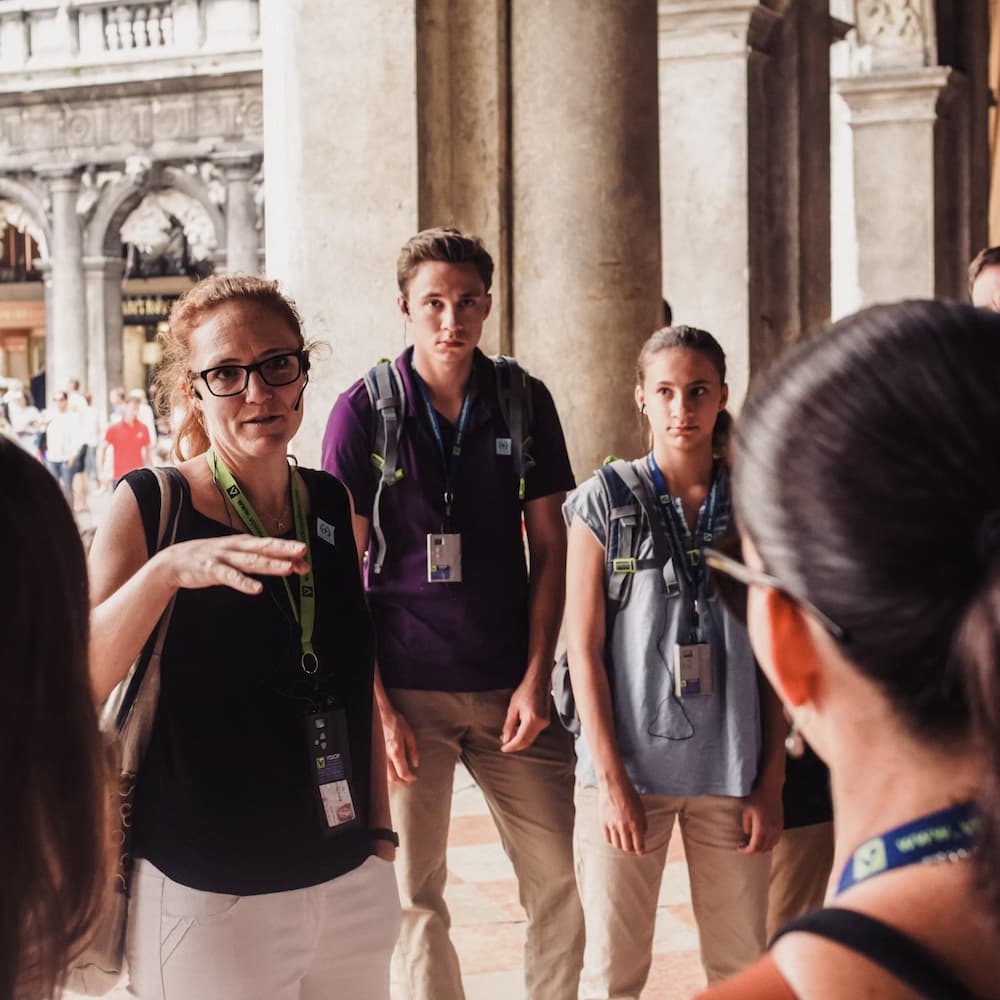
Secret Itineraries Tour Venice: guided tour tickets
Buy online. Choose the time you prefer. Join the Doge’s Palace Secret Itineraries guided tour and gain access to the Doge’s Palace by skipping the ticket line.
You can cancel for free up to the day before your visit.
Table of content
- 1 Secret Itineraries of the Doge’s Palace: useful info
- 2 What is Secret Itineraries Doge’s Palace in Venice?
- 3 Secret Itineraries Doge’s Palace Venice tour in detail
- 3.1 Pozzi
- 3.2 The cells on the second floor
- 3.3 The Parlatorium
- 3.4 The connecting staircase between the Bridge of Sighs and the Piombi
- 3.5 The ducal notary’s office
- 3.6 The office of the Grand Chancellor
- 3.7 Office of the Voices Secretary
- 3.8 The secret archive
- 3.9 The Torture Room
- 3.10 The Piombi and Giacomo Casanova’s cell
- 3.11 The attic
- 3.12 Casanova’s second cell
- 3.13 Hall of the Three Chiefs of the Council of Ten
- 3.14 The Office of the Three State Inquisitors
- 4 Conclusion of the visit
- 5 Venice Secret Itineraries: things to know before your visit
- 6 Secret Itineraries Tour: tickets and reservations
- 7 Secret Itineraries Tour reviews
- 8 Visiting the Secret Itineraries of the Doge’s Palace: frequently asked questions
- 9 Secret Tour Doge’s Palace: conclusions
Secret Itineraries of the Doge’s Palace: useful info
- Duration of the visit: 3 h
- Full price ticket: 95€ (the ticket includes the visit to the Doge’s Palace in addition to the guided tour)
- Reduced price ticket*: 85€ (the ticket includes, in addition to the guided tour, also the visit to the Doge’s Palace)
- Timetable: 09.15 a.m. (Italian)
- Language: Italian, English, French.
- Number of participants: from a minimum of 2 to a maximum of 15 people.
- Accessibility: The visit involves the use of several stairs, so unfortunately it is not accessible to people in wheelchairs or with mobility difficulties.
- Starting point of the visit: The visit begins near the baths, on the right-hand side of the Ducal Palace courtyard. From here the guide will lead you along the route of the secret itineraries.
*Residents and those born in the Municipality of Venice; children from 6 to 14 years old; students from 15 to 25 years old with student card; citizens over 65 years old; RollingVenice Card holders; VeneziaUnica Pack holders; MuveFriend Card holders, St Mark’s Square Museums ticket purchasers, Museum Pass holders; Clock Tower ticket holders; I.C.O.M. members, staff of the Ministry of Cultural Heritage and Activities, ISIC – International Student Identity Card holders.
What is Secret Itineraries Doge’s Palace in Venice?
On the Secret Itineraries Tour you will enter the part of the Doge’s Palace used for the administration of justice in criminal cases. The name ‘secret’ alludes to the fact that these rooms are hidden in the palace, behind closed doors.
Starting from the dungeons on the ground floor, you will pass through the ‘secret’ rooms of the Doge’s Palace where officials of the bureaucracy had their offices and where the supreme judicial body of the Council of Ten, which had to work in secrecy, and the secret archive, where the most important state documents were kept.
Going up to the attic you will reach the upper cells, called Piombi, where political prisoners, sometimes foreigners, were locked up, including the famous Giacomo Casanova, who also managed to escape in 1757.
The tour ends in the square atrium hall, from where you can continue your tour of the palace on your own.
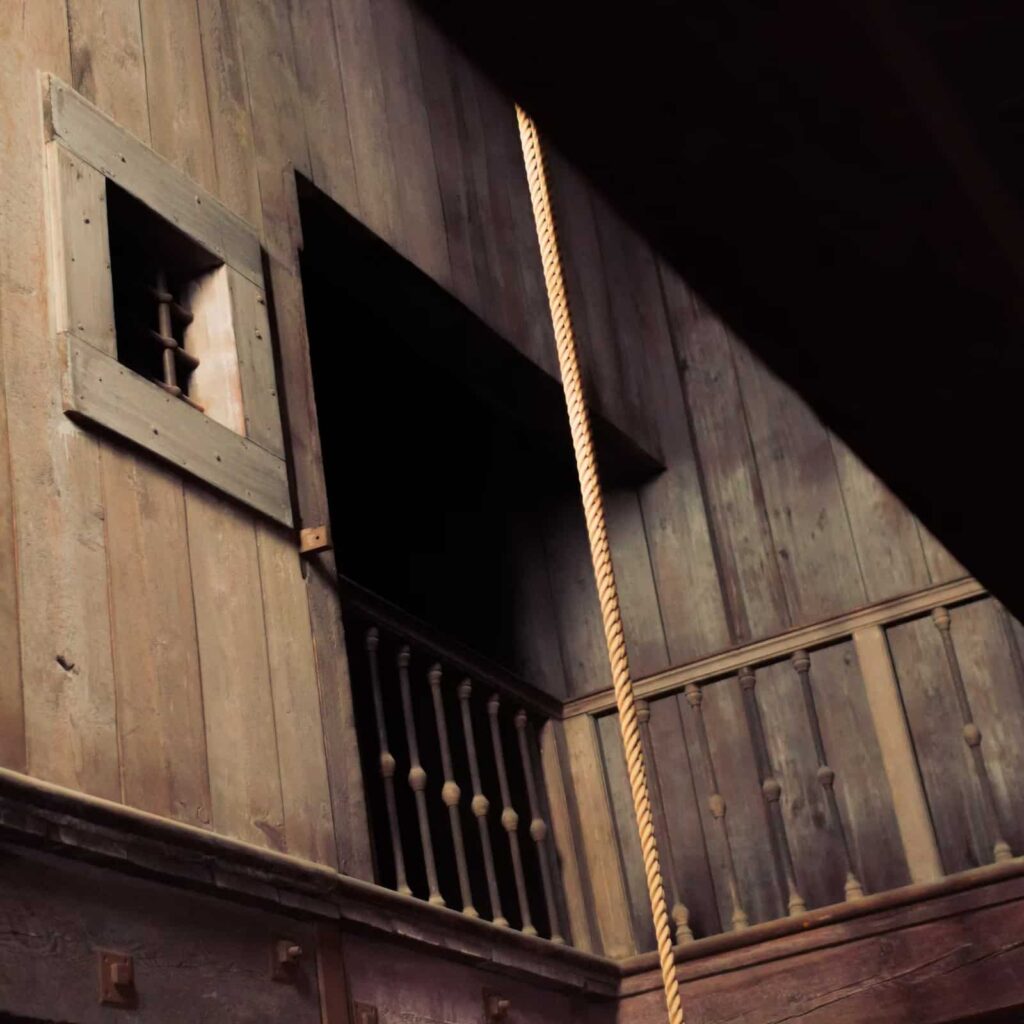
Doge’s Palace: visit Secret Itineraries with professional tour guide
Buy online. Choose the time you prefer. Join the Doge’s Palace Secret Itineraries guided tour and gain access to the Doge’s Palace by skipping the ticket line.
You can cancel for free up to the day before your visit.
Secret Itineraries Doge’s Palace Venice tour in detail
Your tour starts “behind the scenes”, from the cells on the ground floor, the terrifying “Pozzi” (Wells).
Pozzi
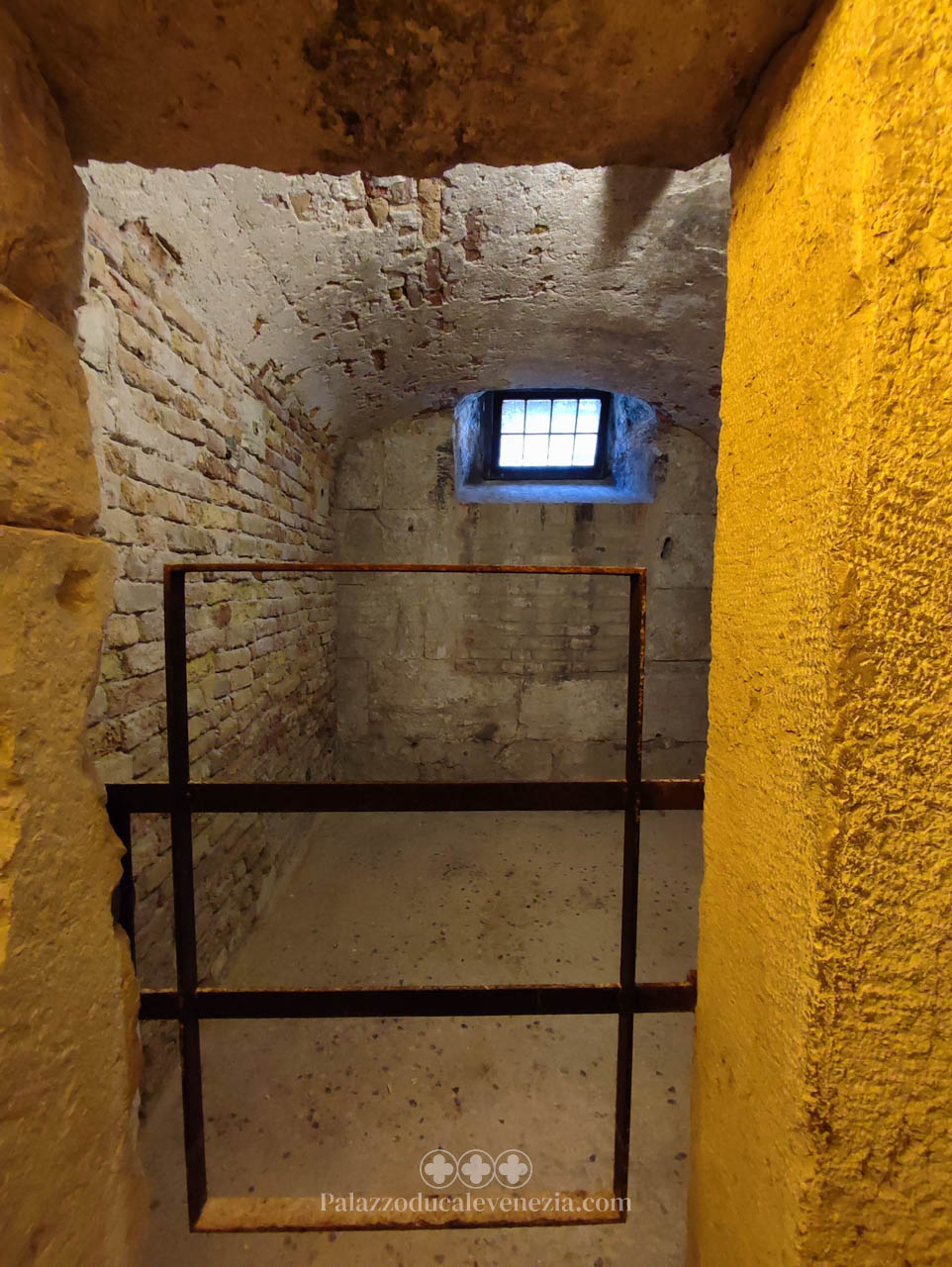
As you will notice, you are right next to the water and the cells were once cisterns, therefore very wet and without windows: real tombs, which were subject to flooding in exceptionally high-water conditions.
The cells are arranged on both sides of the corridor, and part of them is currently closed to the public.
The first room on the right, the only one with a window, was the guards’ post.
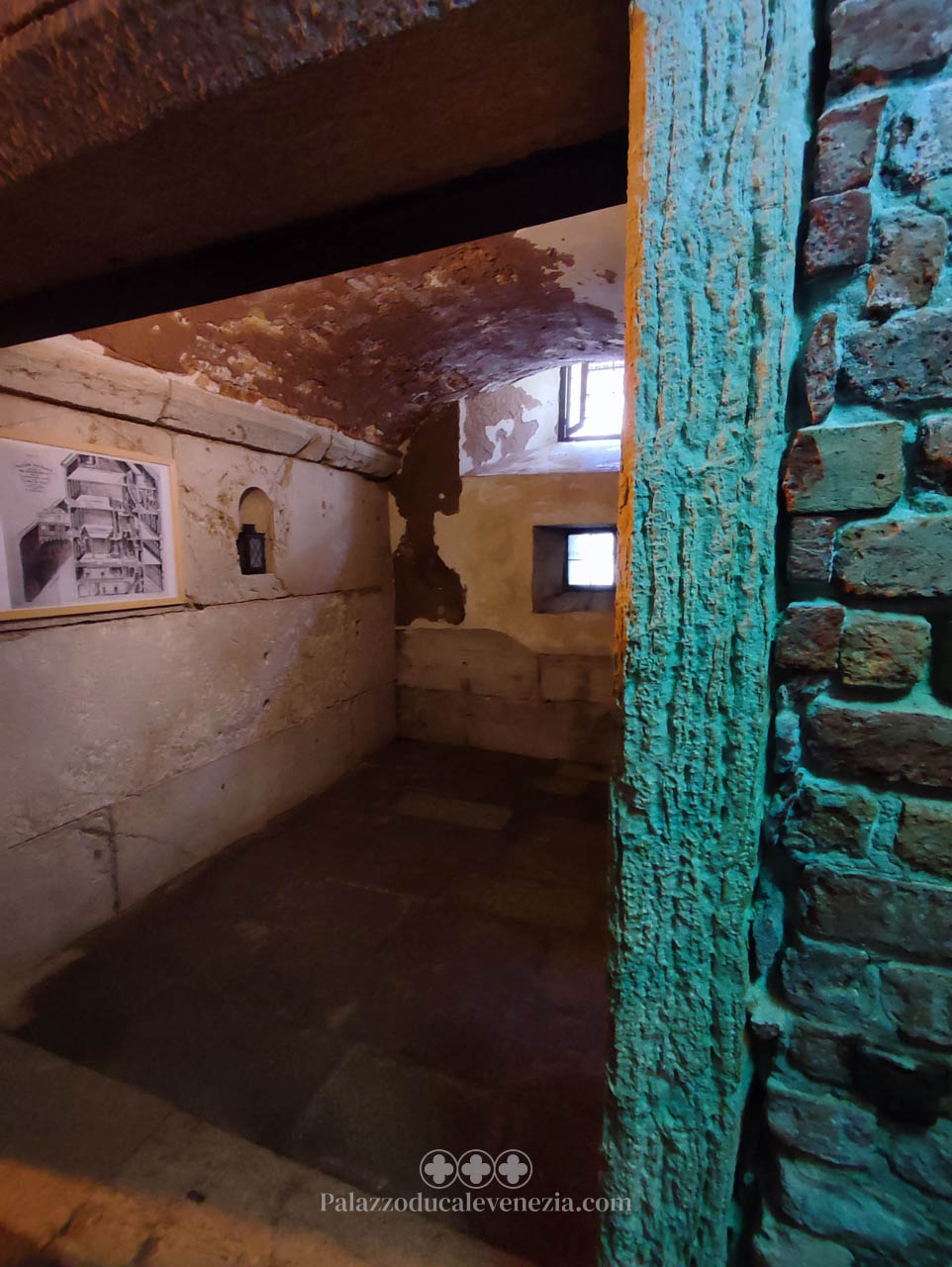
Upstairs there are other slightly larger cells, some with windows.
The living conditions here were borderline, but this should not come as a surprise, as in those days imprisonment was intended to physically punish the condemned.
The cells date back to the mid-sixteenth century, but we know of the existence of prison rooms as early as 1300, named in the same way.
Prisoners could be nobles, non-nobles, or commoners, depending on the crime.
Crimes against the state, especially against the nobility, were punished here, but nobles guilty of murder, conspiracy or violence could also be imprisoned here.
We also know of a prisoner, Alvise Bon, locked up in cell number five, for murdering two wives, but spies were also locked up here, guilty of failing to serve the state properly.

The cells were initially not overcrowded because the prisoners were judged by the high court of the Council of X, which wanted to keep the prisoners as separate as possible. In fact, these were always alone in their cells, with a few exceptions of groups of two or three prisoners.
On the wall of the guards’ room you can see a copy of an ancient map with the section of the prisons, and where you can carefully see the route of your visit, which will take you walking behind the courts:
- on the first floor were the avogadors, who had the function of prosecutors, held preliminary investigations and rendered the first degree of judgment;
- on the second floor was located the quarantia, the forty appellate judges;
- on the top floor was the supreme court of the Council of X;
- under the roof were the cells known as Piombi.
As you go forward down the corridor you will notice that the cells are marked with Roman numerals, but the number five was represented upside down as if to say “abandon all hope or you who enter.”
The cells on the second floor

We continue our tour of the Secret Itineraries of the Doge’s Palace by climbing the stairs; you will find yourself in a corridor with other cells, one of which is entirely lined with wood. This was the cell, called the infirmary, where sick prisoners were transferred. When sick people increased, a doctor was called in to try to prevent epidemics.
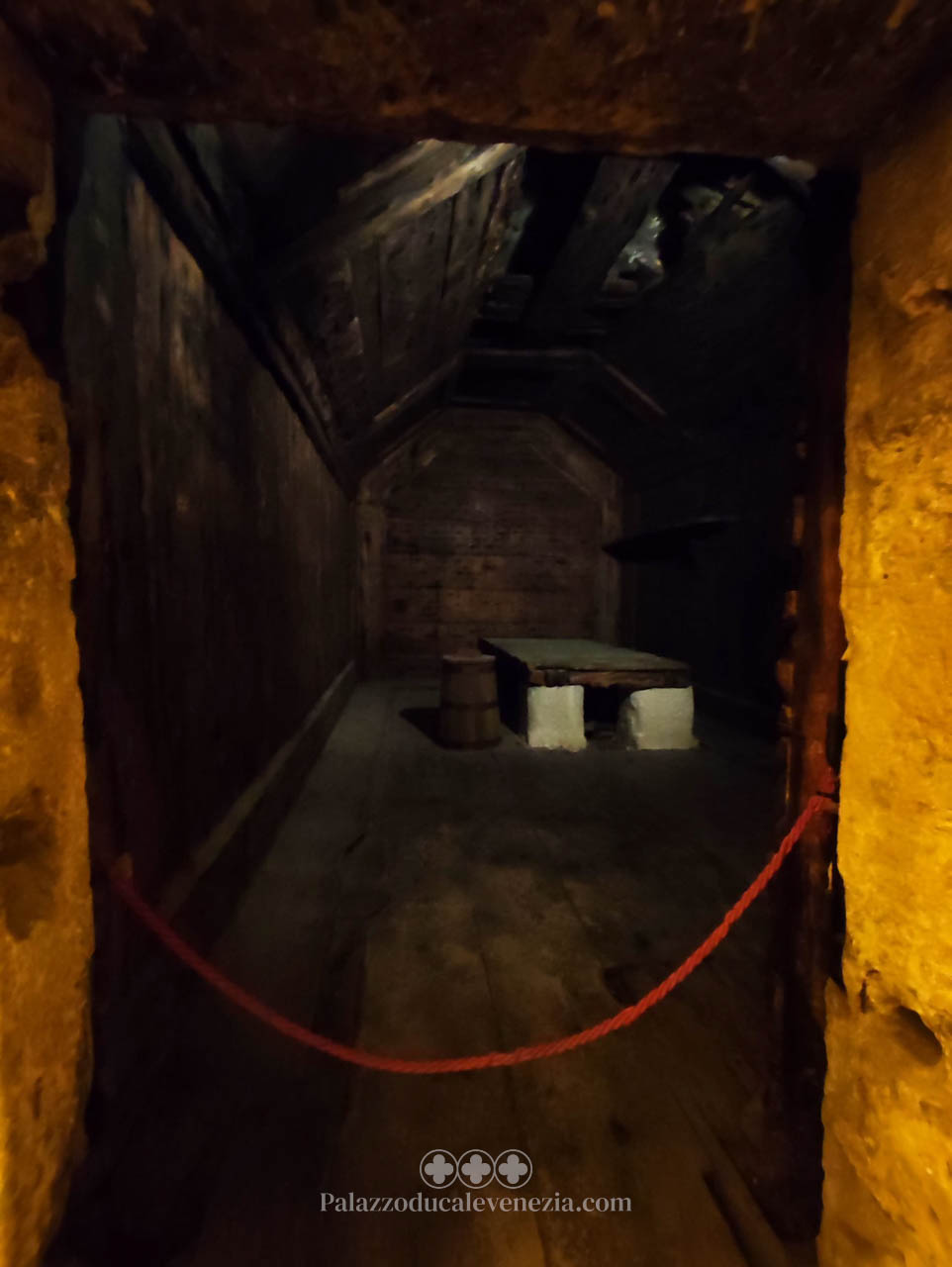
The state passed bread, water and sometimes wine, blankets, and oil for lamps, if someone gave bequests.
In Venice, when wealthy Venetian people made wills, the notary always asked them to leave a bequest for the condemned.
The Parlatorium
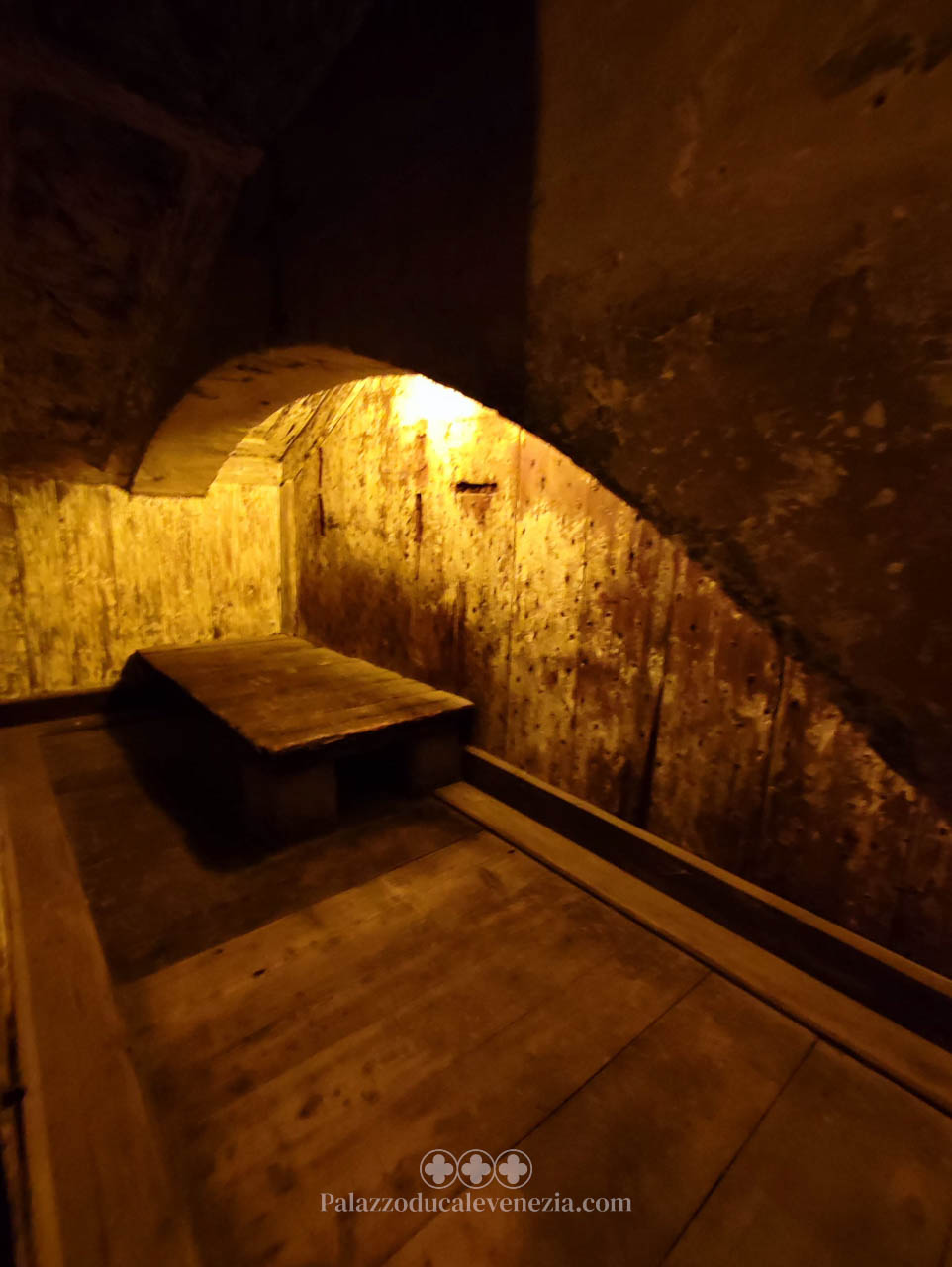
When prisoners were allowed to see their families, in these cases the wood-paneled room to the right of the staircase was used. The location of this room was due to its proximity to the door leading to the Foscara loggia, where family members waited to visit.
When this room below the staircase was not used as a parlor, it was used as a prison cell.
The connecting staircase between the Bridge of Sighs and the Piombi
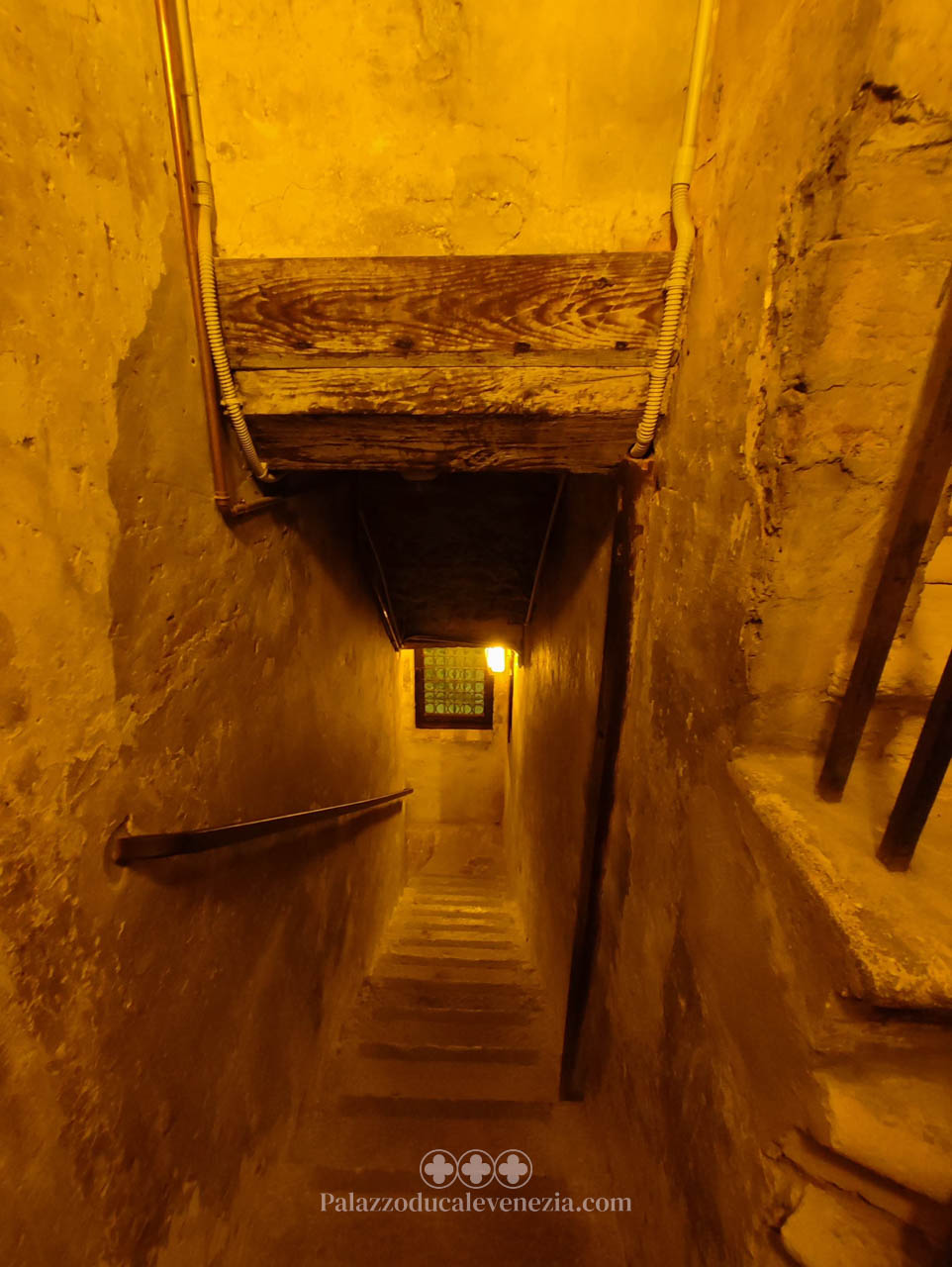
Continue up the stairs, at a certain point you will see two steps descending to your left, this is the way to the Bridge of Sighs from the prisons of the Doge’s Palace Venice, which you will not visit during this guided tour.
Casanova himself, when he was arrested, was first taken to the New Prisons of Venice, made the bridge and climbed the same steps that you will now take to get to the Piombi.
The mezzanine floor houses the offices of the most important officials of the bureaucracy.
The ducal notary’s office
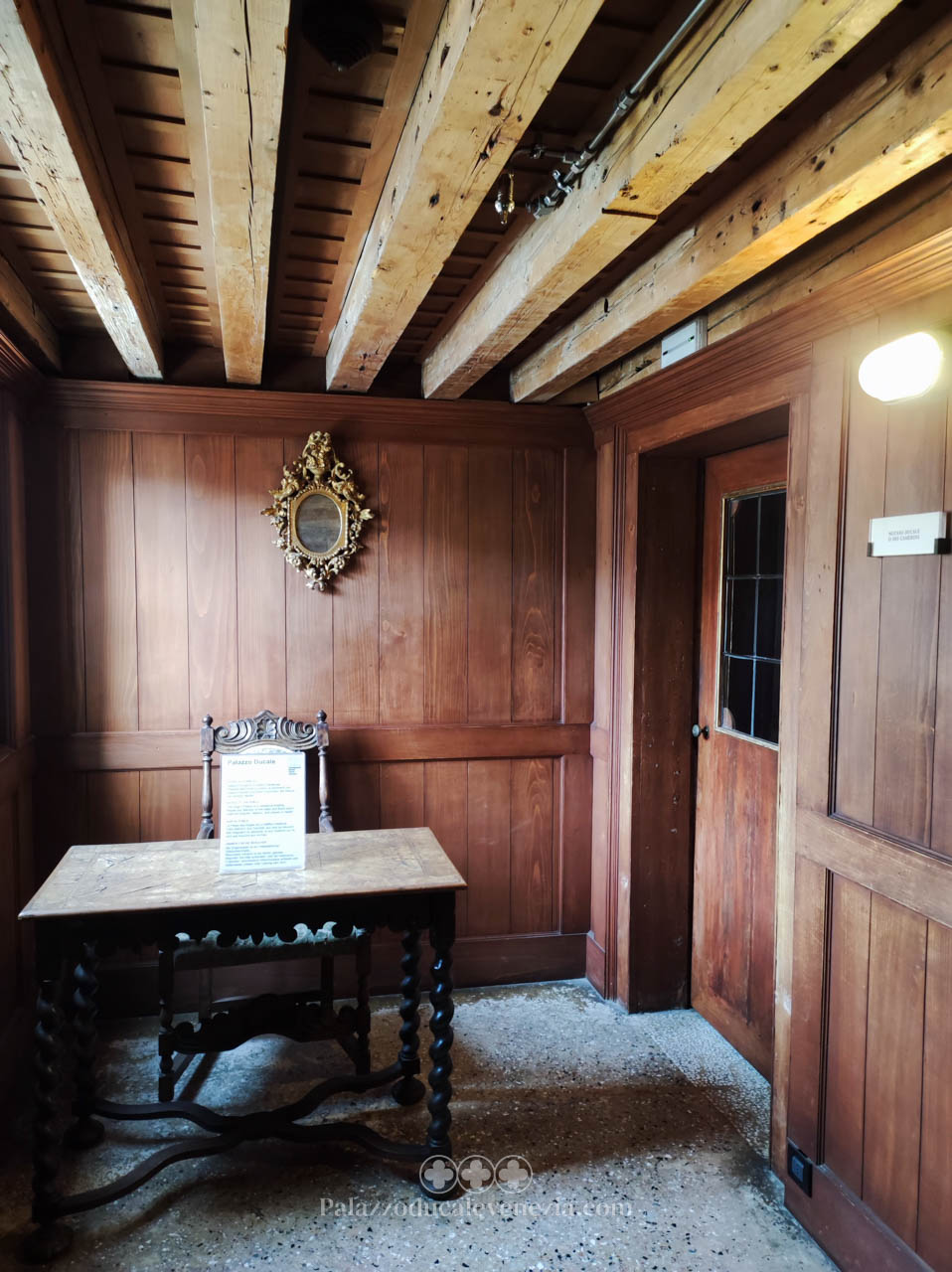
You will see the little office of the ducal notary, who retired from the senate or the doge’s council with letters, treaties, and papers that were then stored in the archive.
This chancery or bureaucratic staff was all made up of non-noble citizens, that is, the bourgeois class.
These people were also intellectuals, who could make a great career, but as non-nobles they did not have the right to vote and could not participate in the great council.
The office of the Grand Chancellor
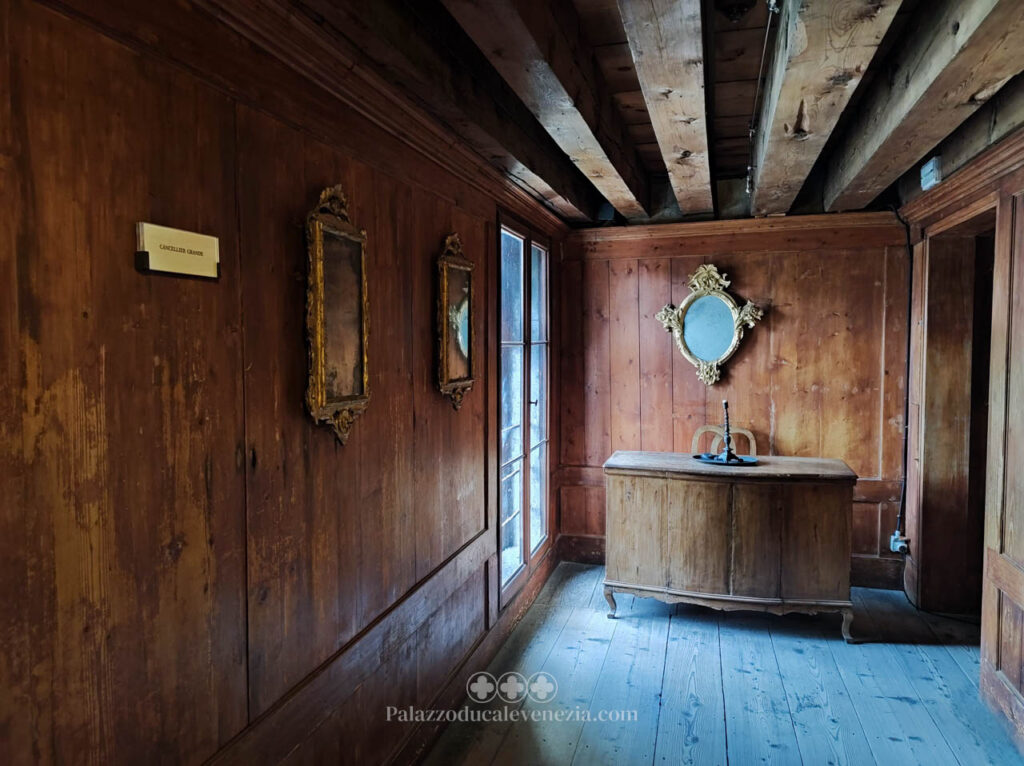
To keep the middle class satisfied, however, the figure of the so-called Grand Chancellor was established as early as 1268. This figure was at the head of this bureaucracy and was the one who was kept abreast of all political, diplomatic matters, could enter all councils and was very close to the doge.
You can see the office of the Grand Chancellor during the visit as soon as you go up the stairs.
The room is very simple, clad in varnished larch wood paneling. The use of wood is due to the need to heat the rooms. In fact, the use of candles was not permitted, given the large quantity of documents that could easily catch fire. The only exception was the magistrates, who had a fireplace in their office.
Like the doge, the Grand Chancellor was elected by the parliament for life, and before the doge he was not obliged to pay homage, because the latter treated him as an equal.
All magistracies were elected by the parliament, these held the three powers: judicial, legislative, and executive. The offices were always collegial and very short (a few months and a maximum of two years).
Office of the Voices Secretary

This was the office of the secretary of elections, who kept track of the entire rotation of offices.
This secretary also kept a sort of blacklist, where he marked those officials who had not performed well in the council or were not suited for administrative life, and for whom no more votes were to be cast.
The secret archive
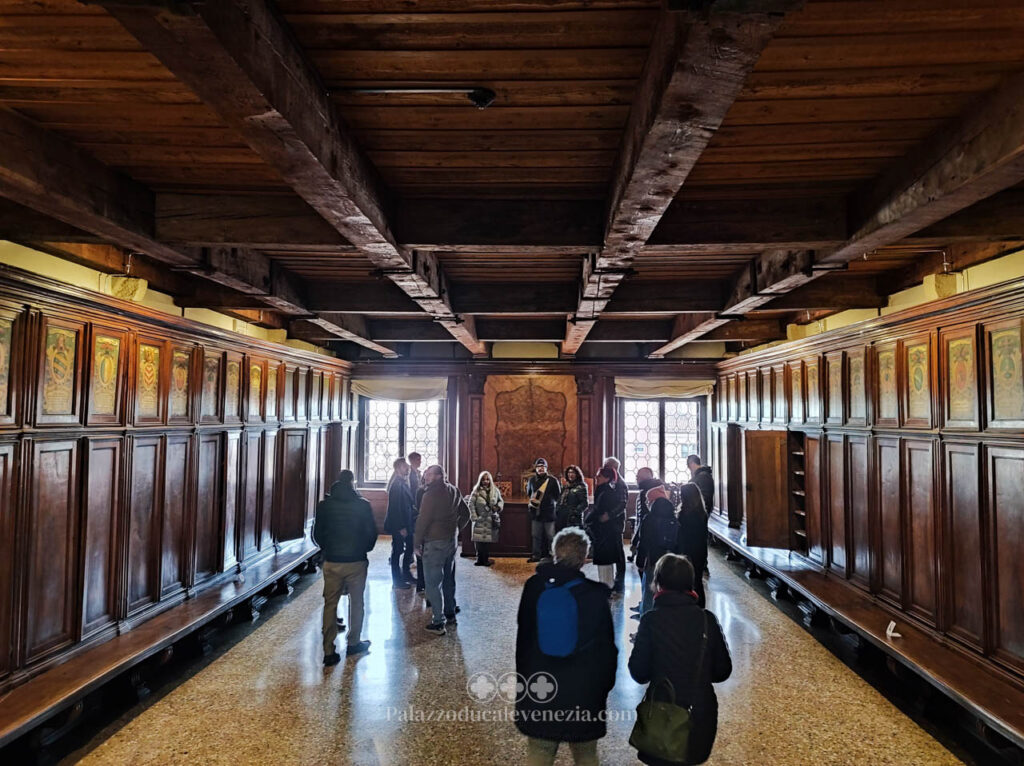
In the center of the room there were rows of desks on which the scribes copied the papers, put the folders in order, trying to keep separate the papers that concerned Venice’s relations with
- the State from Sea (Croatia, Dalmatia, the Balkans and the Greek islands);
- the State from Land (i.e. the mainland dominions such as Venetia, Friuli, Lombardy);
- the other states (Egypt, Persia, Turkey, North Africa);
- the empire;
- the Italian states;
- the papacy.
All these writings, which were also translated into different languages, and of which it was important not to lose track were under the responsibility of the Grand Chancellor and were kept in this archive.
The coats of arms that you see on the cabinets represent the Grand Chancellors: the first coat of arms, near the window, dates from 1268 and goes on chronologically chancellor after chancellor, making a total of forty-four coats of arms out of forty-five chancellors.
The office was held by bourgeoisie, which is why the coat of arms was decided on the spot, often taking cues from surnames: for example, you will see the coat of arms of Chancellor Zuccato, which bears gourds; there are also those who imitate the nobility, those who use more abstract images or reveal the humble origins of the family, such as Chancellor Fornasa whose coat of arms bears a furnace.
The documents that were once kept in this archive are now kept in the Venice State Archives, inside the Franciscan Frari church.
The Torture Room
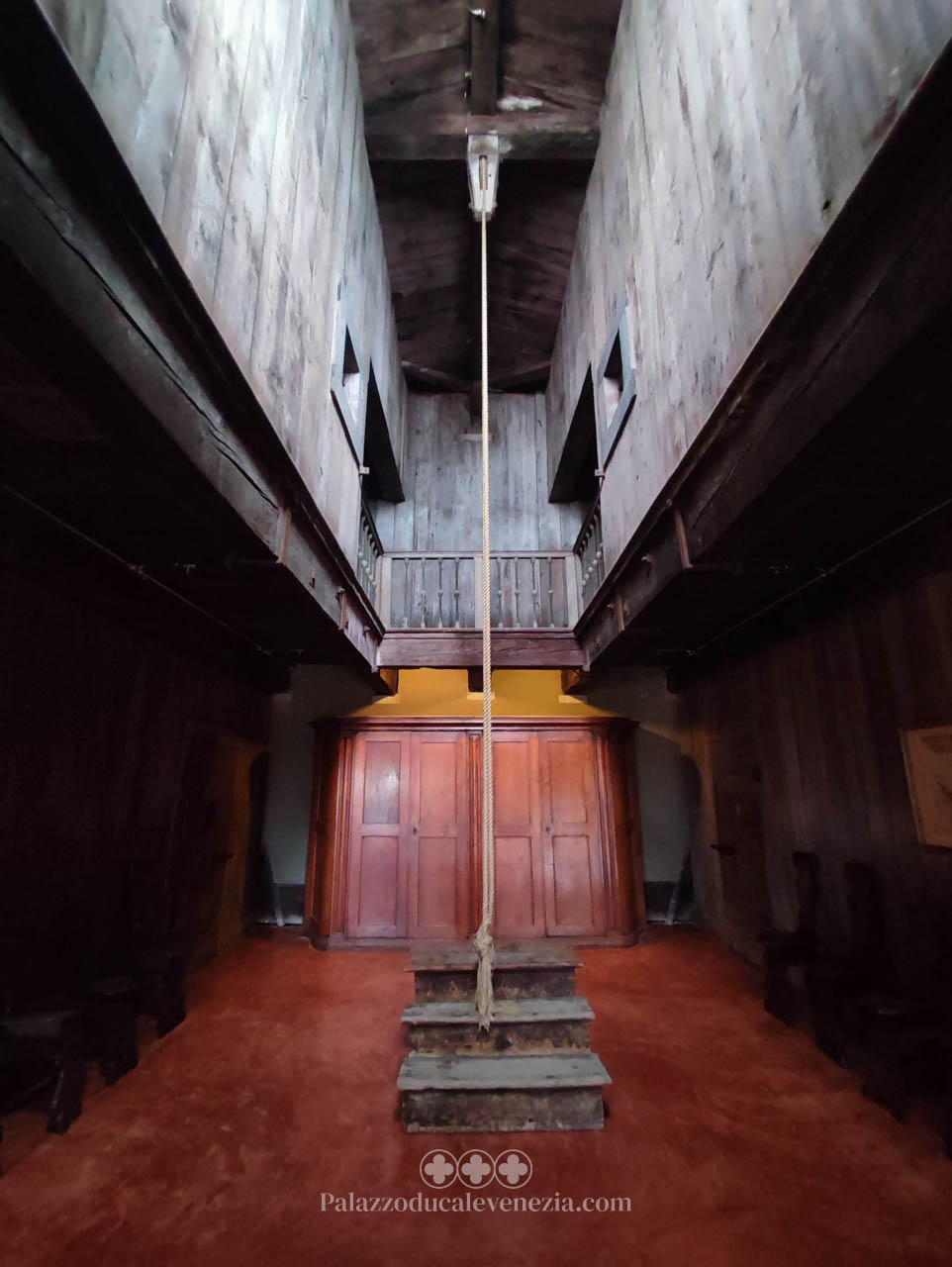
This room is halfway between offices and prisons, it is a room with a desk, but if you raise your head you will see cells: this is where the interrogations of the three chief magistrates of the Council of X (who only intervened in matters of state) took place.
When a person was arrested, the arrest time was a maximum of three days, so the interrogations had to be very quick; if there was not enough evidence of the crime to prepare the investigation in this time, the suspects had to be released.
Those waiting in the upper cells are already prepared by the sight of the rope you see in the center of the room, the torture instrument that was used during interrogations.

The prisoner is led to the floor below. The lights are switched off and the suspect can only hear the voice of the judges as they interrogate him, concealed by the darkness.
If the prisoner did not satisfy their questions, did not answer or denied, he was tied to one of two ropes with his elbows and wrists behind his back, while the other rope was pulled up.
The actual torture consisted of ‘giving the stretch’: the rope was pulled slightly upwards with a pulley and then suddenly torn off.
If one went too far with this method, the unfortunate victim risked having his rib cage crushed.
To ‘try’ to avoid this, a doctor was always present during the sessions and people who were too old, too young or frail were not tortured.
This method was abandoned at the end of the 17th century (because of numerous miscarriages of justice), as was the death penalty, which was gradually abandoned, partly because of the many tourists from the European elite who visited St. Mark’s Square in the 18th century (this was where the executions took place).
The Piombi and Giacomo Casanova’s cell

Illustrious people were also imprisoned in Venice’s prisons, including the famous Giacomo Casanova.
Born in 1725, at the age of nine he was sent to Padua following the death of his father, so that he could study with the priests and later enroll at university.
A great adventurer and scholar, he tried his hand at chemistry, medicine and was also attracted to ‘secret’ disciplines such as alchemy.
During one of his stays in France, he joined Freemasonry, and on his return to Venice, he established relations with the nobility who attended the sessions of the parliament, trying to convince them to join the association.
When the magistrates learned that Casanova had had relations with the French ambassador at night, they accused him of espionage and had him arrested, along with the charge of immorality for his secret relations with girls in a convent.
During the itinerary of the dungeons of the Doge’s Palace, you will reach the attic to the cells known as Piombi, and enter the very cell where Casanova was initially imprisoned one hot July, at the age of thirty.

In the accounts in his book ‘My Escape from the Piombi’, the writer recounts that, once inside, he got a real shock from the excessive heat emanating from the lead-lined cell roof.
After some time, he was given the freedom to move around in the attic.
It was here that he found a piece of iron and a scrap of floor, which he used to devise his first escape attempt.
With the spike, sharpened by the tile, he began to break the floorboards. After a year, the hole was big enough to attempt an escape.
Unfortunately, that was the room above the hall where the magistrates gathered late at night. They heard the noises and gave the order to transfer Casanova to a new cell.
The guide will show you the second cell with a window to which, from the stories, he is supposed to have been transferred, but before continuing with the story of Casanova’s escape you will first go up to the attic of the Doges’ Palace.
The attic
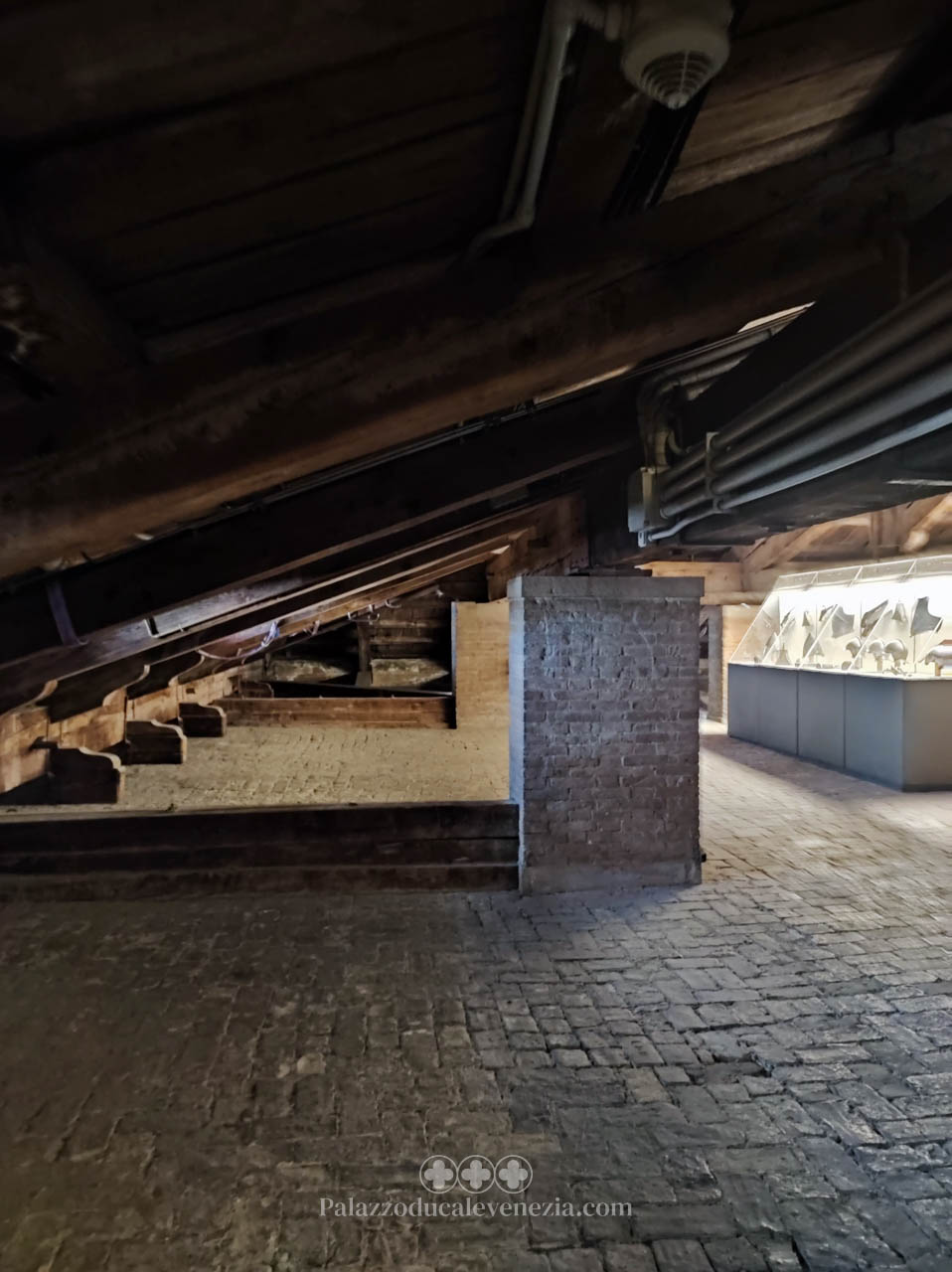
You are above the Hall of the great Council, in the gothic wing of the building, and from here you can admire the stunning wooden structure that supports the ceiling of the hall without the aid of columns.
The structure consists of beams, posts and twenty composite trusses on which the roof rests, all held together by hooks and chains, to which the paintings you will see once in the hall are also anchored. Through this system, the weight is discharged onto the perimeter walls of the hall.
You will notice the resemblance to the keel of an overturned ship, which was actually built by shipbuilders, the so-called ‘arsenalotti’, who worked in the Venetian arsenal but were also responsible for putting out fires.
This wing of the palace was rebuilt within two years after the fire that devastated the palace in 1577.
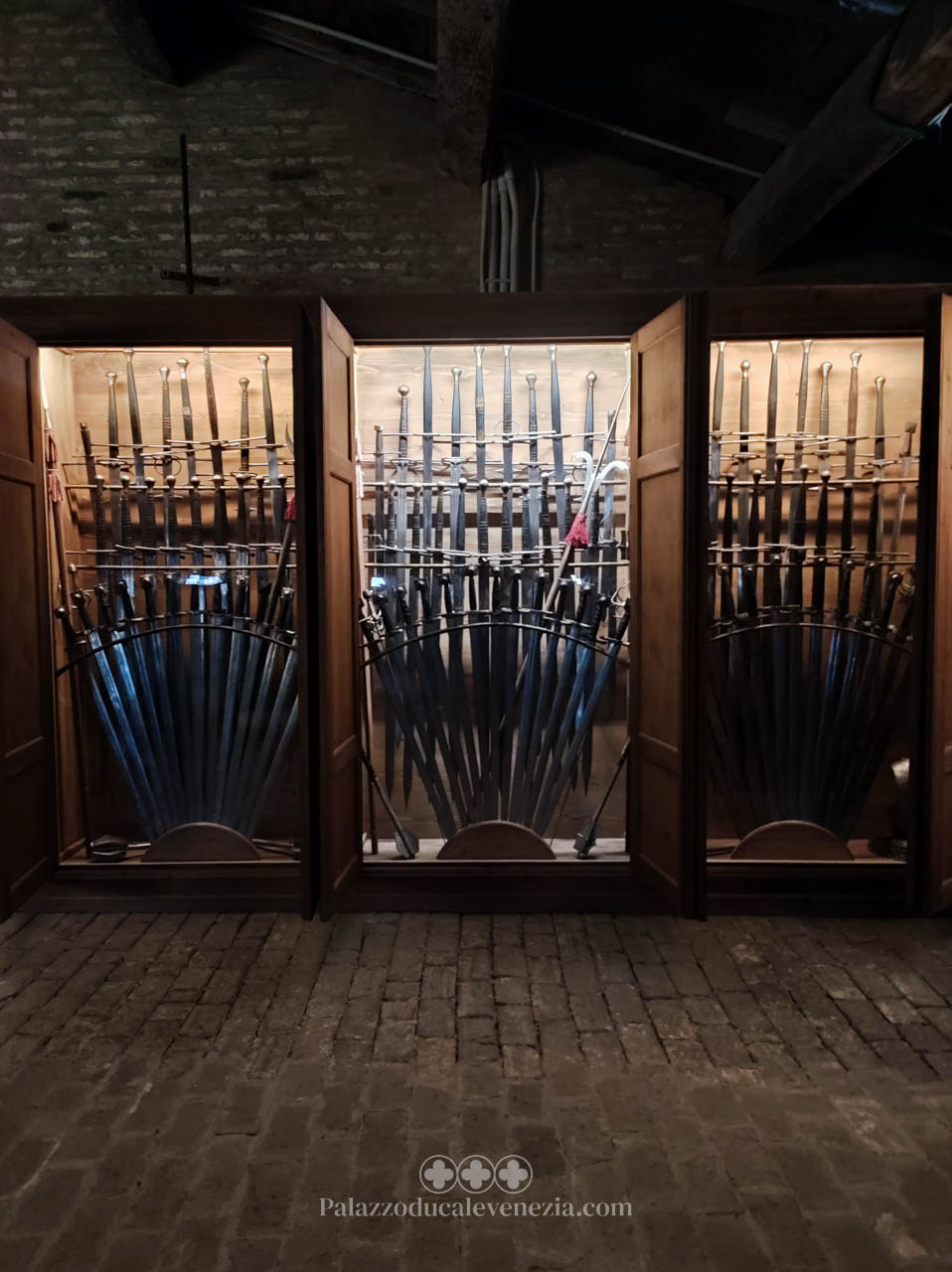
The attic also houses part of the Doge’s Palace armory collection, which, however, was not housed here but on the floor below, which you will visit later.
Casanova’s second cell

Let us move back to the attic cells and continue Casanova’s tale.
During the ‘move’ from one cell to another, Casanova takes with him the armchair in which he had hidden the piece of iron. This is the room from which he manages to escape with the help of another prisoner, held in the cell next door.
Casanova was a great writer, and he tells the story of his escape in great detail.
One day, the guard in his cell informed him that there was a prisoner called Father Balbi, a monk and nobleman, who kept books. Casanova and Balbi started exchanging volumes and began writing messages to each other, planning their escape, unbeknownst to the guards who could neither read nor write.
During the feast of St Michael the Archangel, Casanova will pass iron inside a large volume of the Bible covered by a pasta dish, given to Father Balbi, who will then be able to start digging a hole in the ceiling of his cell, which he shares with Casanova’s.
Having also dug the hole in the ceiling of the second cell, the two manage to climb to the roof.
Entering through a skylight, they will enter the archive room, break through the door and descend the Golden Staircase, which they will find closed by a gate.
Luckily, however, that is the night of All Saints’ Day, and there are many visitors in Venice.
Casanova changes into the gentleman’s clothes he was wearing at the time of his arrest, while Balbi remains dressed as a monk.
In the morning, the Palazzo’s caretaker reaches the gate to re-open the lock and sees the two men dressed normally. The two pretend to be lost and walk out of the Palace to a gondola.
The two separate and Casanova flees to Germany, then to France, while Father Baldi goes to Switzerland.
The guardian, named Lorenzo (from the documents that prove it), will instead be punished, ending up in the “Pozzi”.
The guide will now take you down to a secret passageway that will lead you out of a fake wardrobe into the hall from which the magistrates reached the prisons.
Hall of the Three Chiefs of the Council of Ten

You are in the Hall of the Three Chiefs of the Council of Ten.
The three magistrates had to prepare the trials, and here they received visits from prisoners and witnesses who entered through the second door you will see in front of you.
There was also a waiting room where they waited before testifying, called The Compass (after the name given to the door).
Having prepared the papers for the prosecution and those for the defence, the magistrates would appear before the doge and his six councillors in court, together with the entire Council of Ten.
The inquisitorial proceedings took place in the absence of the accused, but there was one form of defence: the penalty lawyer.
The room has been preserved as it was in the 16th century. The 1555 ceiling features oil paintings, two of which are by Paolo Veronese: Victory over the Sinner and Justice Punishing Counterfeiters.
In the centre is Zelotti’s canvas, Virtue Defeats Vice.
The Office of the Three State Inquisitors
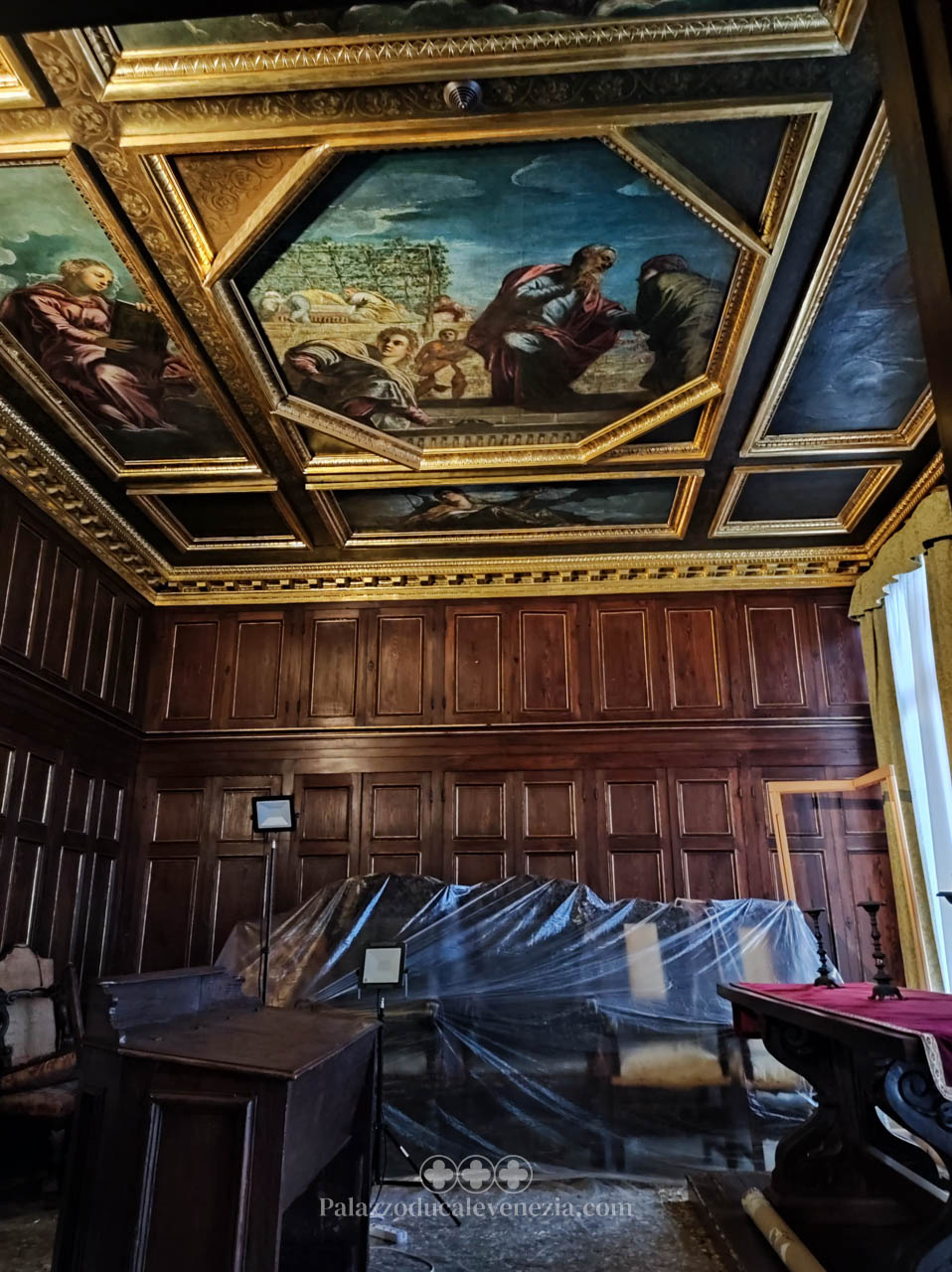
The room is connected to another smaller room, which you cannot enter, is another office for magistrates, that of the Three State Inquisitors, a secret service that supervised the Ten.
Inside the room is a painting by Jacopo Tintoretto, The Return of the Prodigal Son.
Conclusion of the visit
The visit ends here and your guide will take you to the Golden Staircase, in the Square Atrium, from where you can continue your tour of the Palace.
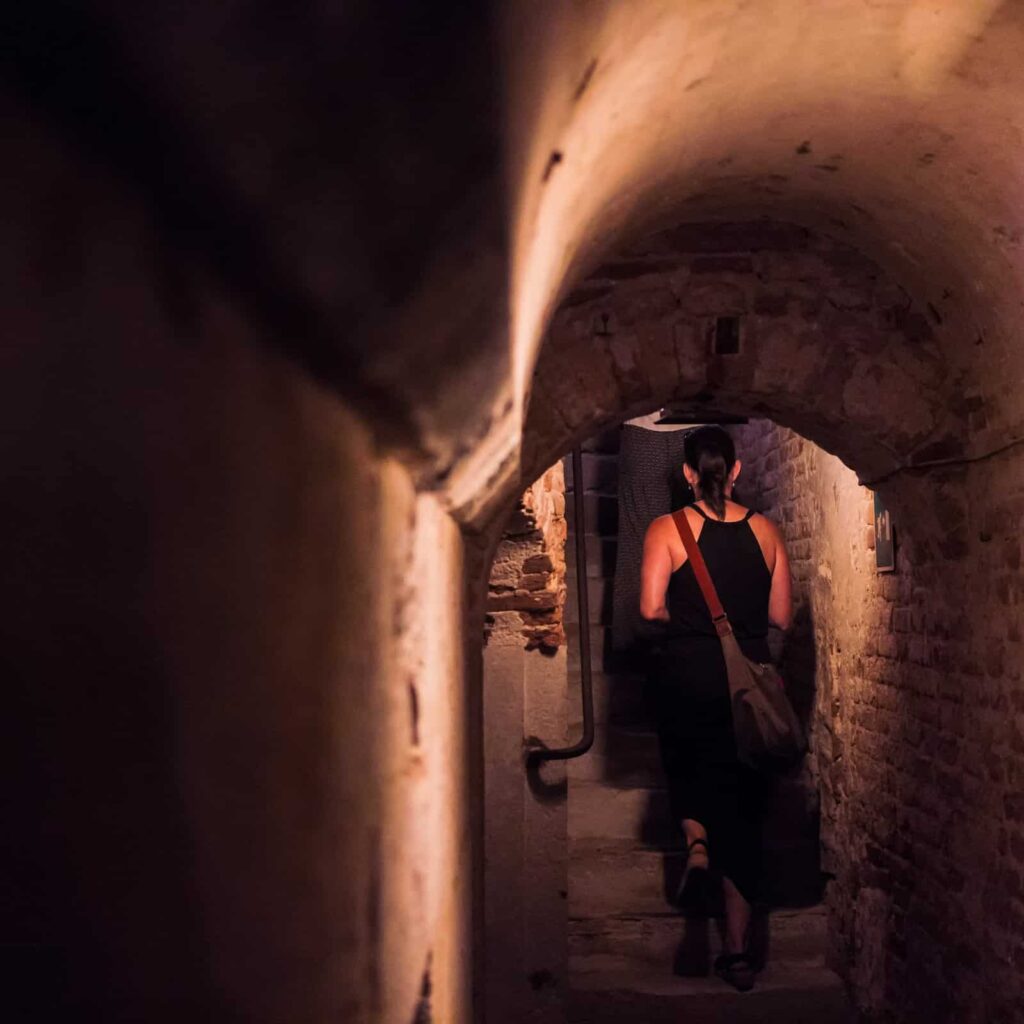
Secret Itineraries tour tickets: book your guided tour now
Buy online. Choose the time you prefer. Join the Doge’s Palace Secret Itineraries guided tour and gain access to the Doge’s Palace by skipping the ticket line.
You can cancel for free up to the day before your visit.
Venice Secret Itineraries: things to know before your visit
Before starting the tour, an introduction on the administration of the Venetian state will be useful. Obviously, the history of Venice is very long, because we are talking about almost eleven centuries of history.
Tradition counts 120 doges, the first being elected in 697 A.D. while the last, Lodovico Manin, abdicated before Napoleon.
Under the tenth doge, in the 9th century, a first building called the castellum was built, a kind of fortress with corner and watch towers. The medieval building was later replaced by a first real palace in Byzantine style, Venice was in fact very close to Constantinople, which is why many buildings in the city, including St Mark’s Basilica, follow the dictates of this architectural style.
The chronicles tell of a beautiful palace with arches and loggias, but little remains of it following the numerous alterations that affected the palace.
The palace changed to the Gothic style in the mid-14th century; the Gothic façade is the one you entered through. The reason for this major renovation was the need for a large assembly hall; in fact, the structure of the Venetian parliament was revised in the same years. The parliament is not to be understood as today’s, with parties confronting each other, but as a general congress of nobles, in fact an oligarchy.
At the beginning, these noble families were descendants of the founding families, new families were later born, while others were even excluded from the council. At the end of 1200 one of the most painful reforms was implemented, the Serrata del Maggior Consiglio. The purpose of this reform was to review which families should be entitled to be part of this elite. In the end it was decided to guarantee a kind of heredity of office, keeping those who had been members of the council up to then and had already reached the age of 25, which meant that those who had reached the age of majority could enter the council, which was to become an enormous assembly, about a thousand people.
Thus the need arose to enlarge the palace and it was at this stage that the famous Hall of the Great Council was built, with its spectacular ceiling that is not supported by columns, but hung by chains anchored to the roof structure, which you will see on this visit.
The wing of the palace to the left of the entrance is built in the same style but dates from almost a century later. It once housed the palace library, which was later moved to the Marciana library to make room for a large hall, the scrutiny room.
In the 15th century a devastating fire made new renovations necessary, the Renaissance wing of the Palace was built and among these interventions the Giants’ Staircase, one of the earliest examples in Venice of Renaissance-style architecture, by architect-sculptor Antonio Rizzo, is very interesting.

Secret Itineraries of the Ducal Palace: guided tour tickets
Buy online. Choose the time you prefer. Join the Doge’s Palace Secret Itineraries guided tour and gain access to the Doge’s Palace by skipping the ticket line.
You can cancel for free up to the day before your visit.
Secret Itineraries Tour: tickets and reservations
If you are interested in participating in the special itinerary of the Secret Itineraries of the Doge’s Palace in Venice, online booking is recommended. By purchasing tickets in advance, you have the opportunity to enter the Doge’s Palace skipping the queue at the ticket office and easily take part in the guided tour.
Ticket reservation prices are as follows:
- Full price ticket: €95 (the ticket includes the guided tour and a visit to the Doge’s Palace).
- Reduced ticket price*: €85 (the ticket includes, in addition to the guided tour, a visit to the Doge’s Palace).
*Residents and those born in the Municipality of Venice; children from 6 to 14 years old; students from 15 to 25 years old with student card; citizens over 65 years old; RollingVenice Card holders; VeneziaUnica Pack holders; MuveFriend Card holders, purchasers of tickets for St Mark’s Square Museums, Museum Pass; Clock Tower ticket holders; I.C.O.M. members, staff of the Ministry of Cultural Heritage and Activities, ISIC – International Student Identity Card holders.
Secret Itineraries Tour reviews
Is the Secret Itineraries Tour worth it? What is the opinion of the participants?
This article was written by a member of our team, a participant of the guided tour. Like many visitors, he noted the high competence of the tour guide, ready to answer every question.
The most appreciated peculiarity lies in the possibility of exploring otherwise inaccessible parts of the palace, making the tour extremely interesting.
Although the cost is not low, the experience proves to be a worthwhile investment for every euro spent.
Visiting the Secret Itineraries of the Doge’s Palace: frequently asked questions
The Secret Itineraries of the Doge’s Palace are only accessible with a guide. You can book a group tour ticket or opt for a private guide.
No, the Secret Itineraries can only be accessed with a guide. It is not possible to access them independently.
The Secret Itineraries of the Doge’s Palace offer a journey through the centuries of the Serenissima, showing the crucial activities related to state administration and the exercise of power. Through various rooms, this tour captivatingly presents the civil and political history of Venice, exploring its organizational structure and judicial systems.
The internal structures have small spaces, and some passages extend over several floors, connected by narrow and steep staircases. These rooms are not suitable for people with disabilities, difficulties of movement, claustrophobia, vertigo, or cardio-respiratory problems. Furthermore, they are not recommended for pregnant women.
Admission is only permitted from the age of 6.
Yes, included in the ticket price is also the entrance for the ordinary visit to the Doge’s Palace in Venice.
Yes, just go to the meeting point for the Secret Itineraries at the beginning of the guided tour.
Secret Tour Doge’s Palace: conclusions
Great, we have completed the visit of the Secret Itineraries of the Doge’s Palace in Venice. You can now continue exploring the rest of the museum. I recommend you return to the square atrium at the entrance of the tour to make sure you don’t miss a single room.
If you would like more details, I invite you to read the in-depth look at the other guided tour: the Doge’s Palace Hidden Treasure Tour.

